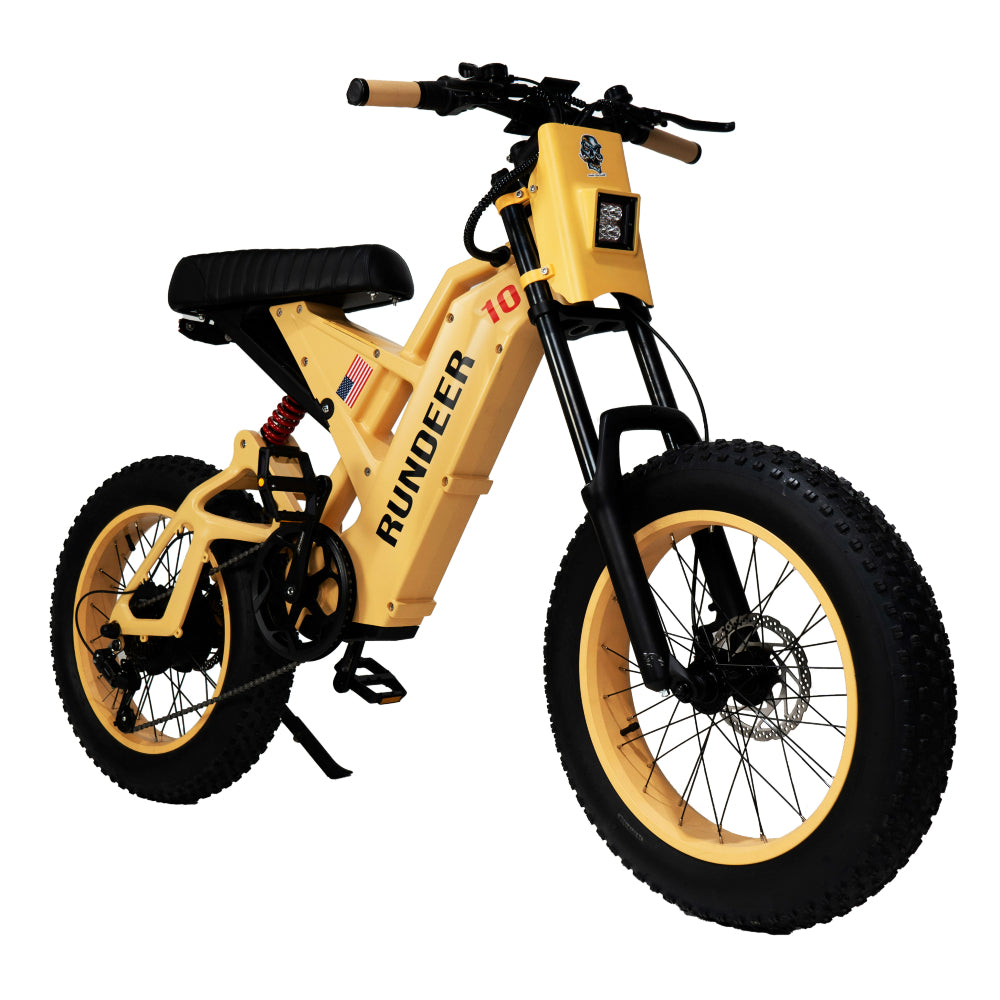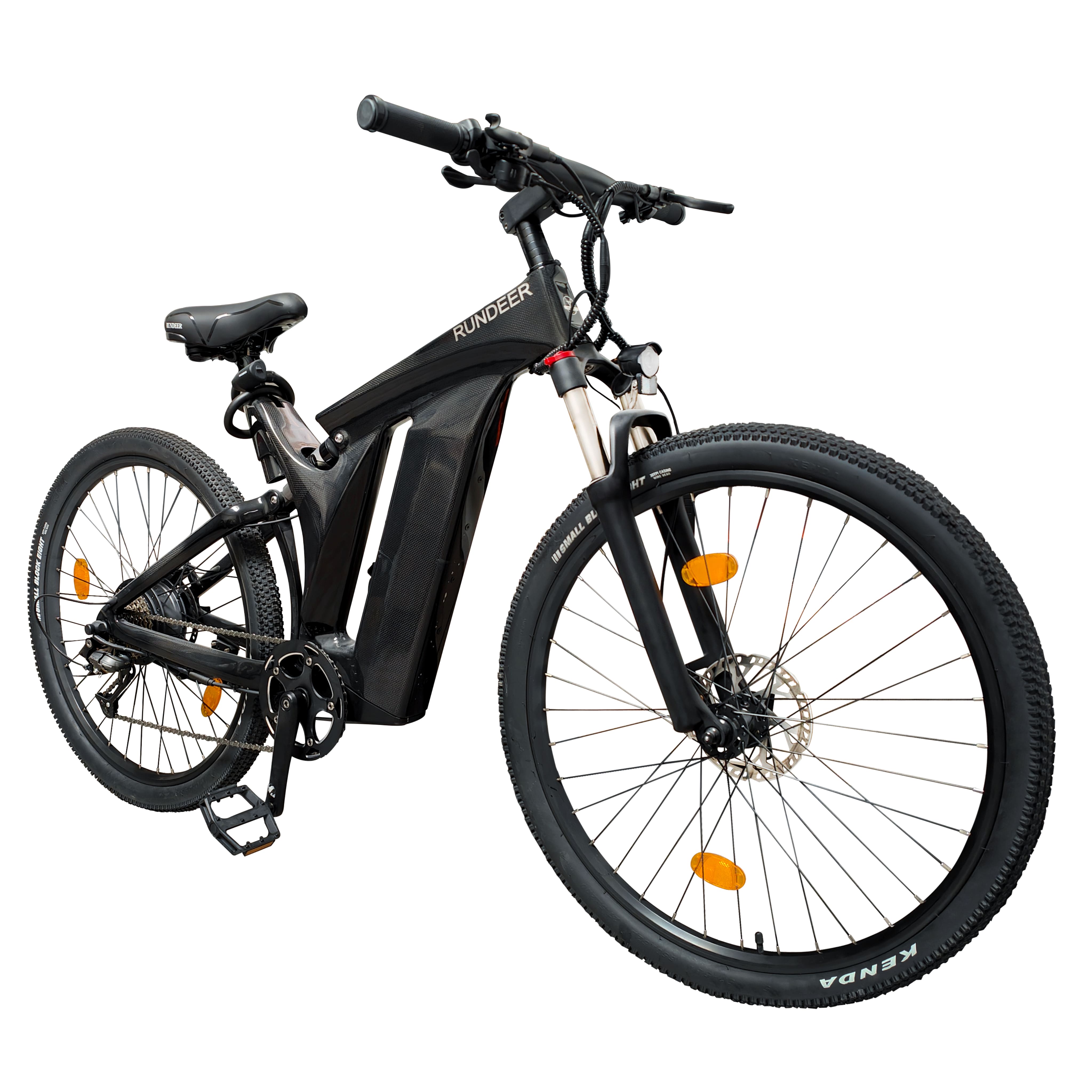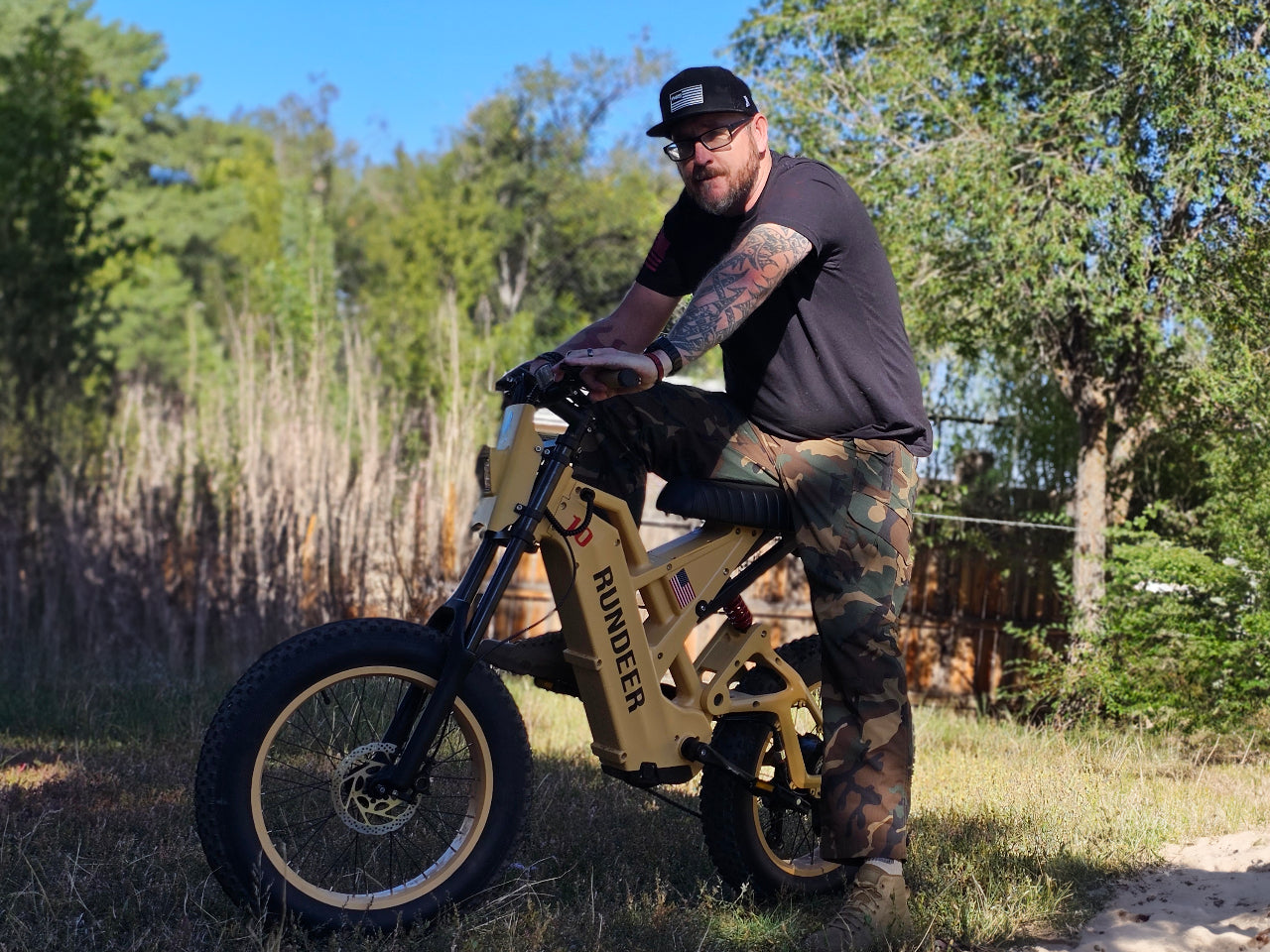Electric off-road bikes have changed the way people enjoy the outdoors by making it easier for more tourists than ever to get to hard-to-reach places. When you ride these strong machines, you can use electric motors to help you. They help people get out into nature and enjoy it more. If you want to learn more about off-road e-bikes or just want to get more out of your time outside with electric help, this guide offers a comprehensive overview of what you might need to know.
What Are Off-Road Electric Bikes?
Off-road electric bikes, also called electric mountain bikes (eMTBs) or all-terrain e-bikes, are electric bikes that are carefully made to handle rough, unpaved areas and difficult environments. Standard e-bikes are mostly made for traveling in cities. Off-road e-bikes, on the other hand, are built to last and have special parts that make them easier to ride on trails, forest walks, mountains, and other natural surfaces.
These adventure-ready bikes are a mix of traditional mountain bike design and electric motor assistance. They let you really experience riding on tracks while also giving you extra help when you get to rough spots.

Purpose and Use: Conquering Natural Terrain
Off-road electric bikes are used for a lot more than just fun. These tools are very useful because they can be used to:
- Exploration of remote trails that might otherwise be inaccessible to many riders
- Long adventure rides without the limitation of physical endurance
- Technical trail navigation with the peace of mind that comes from knowing you have power to help on tough climbs
- Supportive riding experience for individuals with varying physical abilities or those on a recovery journey
Off-road e-bikes are truly revolutionary because they make outdoor activity more accessible to everyone. Riders of all fitness levels can enjoy the thrill of tackling tough terrains together.
Key Differences: Not the Average E-Bike
Off-road e-bikes and their city versions are very different in a number of important ways:
- Frame Construction: Off-road bikes have frames that are stronger so they can handle the pressures of riding on rough ground.
- Motor Power: Typically equipped with more powerful motors (usually 250W-750W) that provide more force for climbing steep hills.
- Battery Capacity: Often include larger battery packs to support extended rides in remote areas where charging isn't available.
- Component Durability: All components, from derailleurs to brake systems, are designed for reliability under extreme conditions.
- Suspension Systems: Feature sophisticated front and often rear suspension to absorb trail shock and maintain traction.
These distinctions reflect the specialized nature of off-road e-bikes, purpose-built to handle the unique challenges of adventure riding.
How Off-Road E-Bikes Work
Mechanical Breakdown: The Power Behind the Pedals
At the heart of every off-road electric bike is a complex system of built-in parts that work together to make riding fast and powerful.
The drivetrain consists of three primary elements:
- Electric Motor: Usually placed in the middle of the bike (mid-drive) or inside the back wheel hub (hub-drive). Mid-drive motors are generally preferred for serious off-road use as they provide better weight distribution and more natural handling.
- Battery Pack: Usually lithium-ion batteries with a capacity of 400Wh to 750Wh that are firmly attached to the frame. These power reserves determine your potential range, which can vary dramatically based on terrain difficulty, assistance level, and rider weight.
- Controller System: The bike's "brain" that controls how much power is sent to the wheels based on what the person does and the help modes they choose. Some more modern systems have torque sensors that check how hard you're pedaling and change the motor power accordingly.
A pedal-assist system (PAS) is what most off-road e-bikes use. This means that the motor only turns on when you're moving. This keeps the real riding experience while giving you a power boost that you can tailor to your needs.
Performance Enhancement: Conquering the Impossible
The integration of electric assistance fundamentally transforms the off-road riding experience in several ways:
Steep climbs that would normally require exceptional fitness become manageable challenges. With the extra power, it's often possible to get through technical parts that would normally require forced dismounts. And maybe most importantly, the general area that can be explored grows a lot.
A well-designed off-road e-bike creates what many riders describe as a "superhuman" feeling—your natural abilities amplified rather than replaced. This subtle but important distinction is what maintains the essence of mountain biking while extending its possibilities.
Key Features of Off-Road E-Bikes for Trail Performance
Essential Components for the Wild
Off-road electric bikes that work well are different from those that don't have a few important features:
⚙️ Tire System
Fat Tires: When driving on loose areas like sand, mud, snow, and gravel, tires that are wider (usually 2.6" to 4.0") and have aggressive tread designs work better. The bigger surface area also helps spread the weight of the motor and battery parts out.
Tubeless Compatibility: Many serious off-road e-bikes come tubeless-ready, allowing riders to run lower tire pressures without risking pinch flats. This makes the bike more stable and comfortable.
⚙️ Suspension Systems
Full Suspension: Some entry-level types may only have front suspension (hardtails), but more advanced off-road e-bikes have back suspension too. This "full-squish" design takes hits from both sides, which keeps you in better control and makes riding on rough ground less tiring.
Adjustable Components: Look for suspension systems with adjustment capabilities for compression, rebound, and lockout to fine-tune performance based on trail conditions.
⚙️ Weatherproofing and Protection
Sealed Electronics: Quality off-road e-bikes have water-resistant sealing around all electrical components to protect against rain, mud splashes, and stream crossings.
Armored Battery Compartments: The battery—one of the most expensive components—should be well-protected against impacts from rocks, branches, and potential crashes.
Bash Guards: Extra security for the motor and drivetrain parts helps keep them from getting damaged by objects and hits from the ground.
Durability and Adaptability: Built to Endure
The true test of an off-road e-bike comes not in the showroom but on the trail, where every component faces the relentless challenges of nature. Superior models have:
- Reinforced Wheel Systems: Stronger spokes, robust rims, and quality hubs to handle the additional weight and forces.
- Sealed Bearings: Throughout the bike to prevent contamination from trail elements.
- Quality Brake Systems: Usually hydraulic disc brakes with larger rotors (180mm+) to provide reliable stopping power under all conditions.
- Modular Design: Allowing for easier maintenance and component replacement when far from service centers.
Durability isn't just about surviving a single epic ride—it's about maintaining performance through countless adventures in widely varying conditions.

How to Choose the Right Off-Road E-Bike
To choose the best off-road electric bike, you need to think about a few important things:
🔍 Motor Specifications
Power Output: Higher watts (250W–750W) usually means more help, but the quality of the power transfer is more important than the number itself. If you want smooth, natural-feeling help instead of jerky power spikes, look for motors that are known for that.
Torque Rating: For off-road riding, especially on steep climbs, torque (measured in Newton meters, Nm) may be more important than wattage. Most good mid-drive motors have power levels between 70 and 90Nm.
Noise Level: Different motors make different amounts of noise, which is important for people who like the peace and quiet of nature.
🔍 Battery Considerations
Capacity: Measured in watt-hours (Wh), higher capacity means longer potential range. For serious trail riding, 500Wh should be considered a minimum.
Charging Time: Most batteries require 3-6 hours for a full charge. Some systems have the ability to charge quickly.
Removability: A battery that can be taken off makes charging easy and lets you bring a spare with you on long trips.
🔍 Frame and Component Quality
Frame Material: For most users, aluminum alloy frames are the best compromise between sturdiness, weight, and price. Carbon fiber makes things lighter, but it costs a lot more.
Drivetrain Components: Look for derailleurs, gears, and cassettes from well-known brands that are stable and can handle off-road use.
Brake Systems: Hydraulic disc brakes are an important part of off-road ride safety because they provide constant and effective stopping power in all kinds of weather. When you press down on the brake lever, fluid moves from the brake lever to the caliper. This makes the stopping smoother and more accurate than with mechanical systems. This better modulation is especially important for heavy e-bikes because it makes sure they work well on rough ground and high drops.
Practical Considerations: Important Real-World Factors
You can only get part of the picture from technical specs. Also think about these practical things:
- Rider Weight Limits: Most e-bikes have weight limits for both the person and the goods. Going over these limits can hurt efficiency and cancel warranties.
- Frame Sizing and Geometry: Proper fit is crucial for control and comfort. Read the manufacturer's size guide carefully. It should have measures like standover height, reach, and inseam length. To find the best fit, compare these measures to the ones on your body. Read reviews from other customers and ask them how they think the bike fits different body types to learn more.
- After-Purchase Support: Find out about the manufacturer's guarantee terms and whether there are any service centers or approved repair shops in your area.
How to Maintain Your Off-Road E-Bike
Routine Checks: Preserving Peak Performance
Regular maintenance is essential for reliability, especially given the complexity and cost of electric components:
✅ Before Every Ride
- Check tire pressure (typically lower than road bikes; exact PSI depends on tire width and terrain)
- Verify battery charge level and secure attachment
- Test brake function and lever feel
- Ensure all bolts and quick-releases are tight
- Check that the display and control systems power up normally
✅ Weekly Maintenance
- Clean the bike thoroughly, being careful around electrical connections
- Inspect the chain for wear and proper lubrication
- Check brake pad thickness
- Examine tires for embedded objects or excessive wear
- Verify that all electronic controls function properly across all assistance modes
✅ Monthly Checks
- Inspect the frame for any cracks or damage
- Check wheel true and spoke tension
- Verify suspension function and look for oil leaks
- Test battery health by monitoring range consistency
- Examine all cables and housing for wear or damage
Seasonal Maintenance: Long-Term Care
Beyond regular checks, schedule more comprehensive maintenance seasonally:
- Professional Servicing: Have a qualified e-bike technician perform a thorough inspection at least annually, including diagnostic checks of the electrical system.
- Battery Storage: If storing your bike for extended periods, maintain the battery at approximately 50% charge in a cool, dry place—neither fully charged nor completely depleted.
- Drivetrain Deep Clean: Periodically remove the chain and cassette for thorough cleaning and lubrication.
- Suspension Service: Follow manufacturer recommendations for fork and shock maintenance, typically requiring professional servicing every 50-100 hours of riding.
- Software Updates: Check for and install any firmware updates for the motor and controller system.
Proper maintenance not only extends the life of your investment but also ensures safety and performance when you're miles from civilization.
Safety Tips for Off-Road Riding
Essential Precautions: Keeping yourself and others safe
Off-road e-biking combines the inherent risks of traditional mountain biking with the added factors of higher speeds and heavier equipment. Follow these critical safety practices:
- Helmet Use: Always use a good helmet made just for mountain riding. For rougher areas, you might want to look at full-face choices.
- Protective Gear: Gloves, knee pads, and eye protection are all must-haves. For tougher trails, you may want to bring extra body armor.
- Pre-Ride Checks: Before every trip, make sure the brakes work, the tires are properly inflated, the battery is charged, and that all the parts are securely attached.
- Weather Awareness: Check forecasts before heading out, and understand how conditions like rain or extreme heat can affect both trail conditions and e-bike performance.
- Trail Etiquette: Learn and follow local rules regarding e-bike access. Yield to hikers and traditional mountain bikers, and never modify your bike to exceed local power restrictions.
- Riding Within Limits: The additional power of an e-bike can sometimes lead riders into terrain beyond their skill level. Progress gradually to more difficult trails.
Skill Development: Building Confidence Safely
Even with electric assistance, off-road riding requires specific skills that develop over time:
- Start on easier terrain: Begin with relatively smooth, wide trails before progressing to a more technical single-track.
- Practice fundamental techniques: Work on weight shifting, braking control, and looking ahead to anticipate obstacles.
- Understand assistance modes: Learn when to use higher power levels (typically for climbs) and when to reduce assistance for better handling.
- Master technical climbs: The unique dynamics of e-bikes on steep ascents require practice—focus on maintaining traction by keeping weight balanced.
- Join group rides: Many bike shops and clubs offer e-bike-specific outings led by experienced riders who can provide valuable advice.
Consider taking a mountain bike skills clinic that welcomes e-bikers to accelerate your learning curve under expert guidance.
Why It's Worth It to Buy an Off-Road E-bike
Easy for beginners to use: Flattening the Learning Curve
Perhaps the most revolutionary aspect of off-road e-bikes is how they transform the beginner experience.
When people first start traditional mountain biking, they often have to go through a tough and discouraging learning process where their physical limitations keep them from fully loving the sport. Off-road e-bikes get rid of this problem by:
- Allowing newer riders to complete longer routes without exhaustion
- Making difficult hills easier to handle with power help
- Enabling mixed-ability groups to ride together without faster riders having to constantly wait
- Providing the confidence to try moderately challenging terrain earlier in the learning process
This accessibility doesn't eliminate the need to develop skills—it simply makes the development process more enjoyable and less frustrating.
The Multiple Benefits: Comprehensive Advantages
The advantages of off-road e-biking extend far beyond simple assistance:
- Fitness Development: Research shows that e-bikers often get great physical workouts because they ride more often and for longer routes, despite what many people think.
- Mental Wellbeing: Access to nature and the "flow state" achieved on trails have well-documented psychological benefits, reducing stress and improving mood.
- Environmental Considerations: When used as alternative transportation to trailheads, e-bikes reduce the carbon footprint compared to driving.
- Community Connection: The growing e-bike community offers social opportunities and knowledge sharing for riders of all levels.
Make Your Next Ride an Off-Road E-Bike Experience
Off-road electric bikes offer the perfect balance of traditional cycling enjoyment with added capability for exploring further and conquering challenging terrain. They provide an accessible entry point for beginners while giving experienced riders new possibilities for adventure. The true value of an off-road e-bike comes from the experiences it enables—connecting with nature, building confidence, and creating memorable journeys on trails that might otherwise remain unexplored. Whether you're considering your first purchase or looking to upgrade, each electrically-assisted pedal stroke can take you deeper into the natural world and closer to the adventure that awaits beyond the pavement. The trails are calling. Are you ready to answer?













